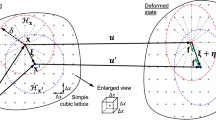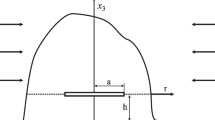Abstract
A unified damage and fracture model, the combinatory work density model, which is suitable for either non-cracked body or cracked body has been suggested[t−7]. In the present paper, the deformation and fracture of the two kinds of tensile spceimen and TPB specimen made of 40Cr steel have been simulated by using the new model together with the large elastic-plastic deformation finite element method. The results give a good picture of the whole deformation and fracture processes of the specimens in experiments; especially, the results on the TPB specimen can be used to obtain the relationship between load and displacement at the loading pointP-Δ, and between crack extension and displacement at the loading point Δa-Δ, the resistance curveJ R -Δa and the fracture toughnessJ 1C . All the results are in remarkable agreement with those obtained by experiments. Therefore the model suggested here can be used to simulate crack initiation and propagation in non-cracked body and fracture initiation and crack stable propagation in cracked body.
Similar content being viewed by others
References
Rice, J. R. and Tracey, D. M.,J. Mech. Phys. Solids,17 (1969), 201–217.
Zheng, C. Q. and Radon, J. C., Proc. of Int. Symposium of Fracture Mech. (Beijing), Science Press (1983), 1052–1056.
Gurson, A. L.,ASME, Journal of Engineering Materials and Technology, 99 (1977), 2–15.
Tvergaard, V. and Needleman A,Acta metall,32, 1 (1984), 157–169.
Zhang, K. S. and Zheng, C. Q., On the Research with Meso-Mechanics of Ductile Fracture and Its Applications, ed. by Zheng, C. Q. NPU Press (1988), 84–98.
Zhang, K. S. and Zheng, C. Q., Advances in Constitutive Laws for Engineering Materials, ed. by Fan Jinghong and Sumio Murakami, International Academic Publishers (1989), 1019–1025.
Zhang, K. S., Zheng, C. Q. and Yang, N. S., A New Model for Predicting Fracture of Ductile Material, Proc. of ICM-6 (1991).
Wang, K., Analysis on the Influence of Temperature and Stress State on Ductile-Brittle Transition, the Thesis of NPU for Eng. M. (1990).
Zhang, K. S., Ma, R. J., Hua, L. S. and Zheng, C. Q.,NPU Journal,6, 3 (1988), 331–341.
Yang, N. S., Wang, D. M. and Guan, Z. X.,Acta Mechanica Solida Sinica, 1 (1984), 77–88.
Author information
Authors and Affiliations
Additional information
The project supported by National Natural Science Foundation of China
Rights and permissions
About this article
Cite this article
Keshi, Z., Changqing, Z. Computer simulated analyses on deformation and fracture of non-cracked and cracked specimens. Acta Mech Sinica 7, 243–250 (1991). https://doi.org/10.1007/BF02487592
Received:
Revised:
Issue Date:
DOI: https://doi.org/10.1007/BF02487592




